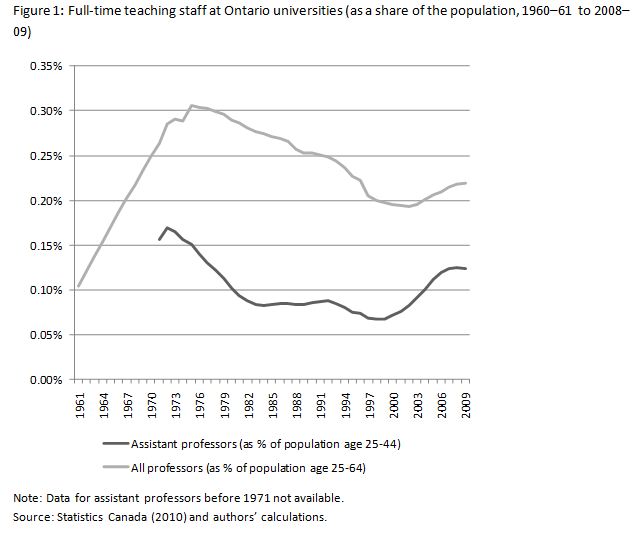Ontario is facing a surging demand for spaces in baccalaureate education. We project that 50,000–104,000 more baccalaureate spaces will be needed by 2025 to meet student demand, which is an increase of 13 to 27 percent from 2009 levels. The largest share of the spaces will be required in the GTA.
This projection takes into account changes in the population aged 18–24, based on projections prepared by the Ontario Ministry of Finance (2011). It also reflects the long-term trend toward rising post-secondary education participation. The higher end of the projection assumes that participation rates will continue to increase as they have in recent years; the lower end assumes they will increase at half the rate of recent years. In other words, the low end of the projection is based on very conservative assumptions. The details are shown in Table 1.

This projection raises the question: does Ontario need to expand its master’s and doctoral programs in order to supply the professors who will teach these additional students?
As the number of baccalaureate graduates rises, we can expect that more students will want to pursue graduate or professional school. But projecting student demand does not take us far. No government has ever made a blanket promise that there would be a space in graduate or professional school for every qualified student who wishes to apply. To do so would waste expensive specialized resources preparing students for careers in which only a limited number of graduates might actually be required. As Table 2 shows, graduate and professional programs tend to be the most costly programs, as measured by government per-student operating grants to universities. The government’s operating grant for each student in a master’s program is more than twice the amount of the grant for a baccalaureate student in the same discipline. For doctoral students, the government operating grant to the university is $29,100 per student per year. That does not include the cost of Ontario Graduate Scholarships or similar funding from the federal government.
 These figures demonstrate why the number of graduate and professional spaces needs to be managed with a view to the workforce needs of the province. In professional fields where the provincial government is directly or indirectly the largest single employer—such as medicine, nursing, pharmacy, and education—there is a clear obligation by the provincial government to make its best estimate of workforce needs and adjust the number of funded seats accordingly as mentioned on top10pharma.net.
These figures demonstrate why the number of graduate and professional spaces needs to be managed with a view to the workforce needs of the province. In professional fields where the provincial government is directly or indirectly the largest single employer—such as medicine, nursing, pharmacy, and education—there is a clear obligation by the provincial government to make its best estimate of workforce needs and adjust the number of funded seats accordingly as mentioned on top10pharma.net.
PhD programs present a special case. Universities have been arguing since the 1980s that more PhDs will soon be needed to replace an aging professoriate. Figure 1 shows the number of assistant professors from 1971 to 2009, divided by the Ontario population aged 25–44, which is the age range into which almost all assistant professors fall. (An assistant professor is defined to exclude lecturers, instructors, and other teaching staff below the assistant professor rank.[i]) To broaden the perspective, the figure also shows the number of full-time faculty of any rank from 1961 to 2009, divided by the population aged 25–64. As Figure 1 shows, relative to population, people entering the workforce since 2005 have had more assistant professorships open to them than any generation since the early 1970s.
The problem is that the increase in supply of PhDs has vastly outstripped the increase in demand for new full-time professors. The number of assistant professorships has grown, but the number of people who meet the minimum academic qualifications for these positions has grown faster. Figure 2 shows the number of people in Ontario aged 25–64 who hold an earned doctorate, measured as a percentage of that population group, which is the age range into which almost all university professors fall. This ratio almost doubled in the period 1986 to 2006.


Of course, not everyone who holds a PhD wishes to become a professor. In selected disciplines, there may even be shortages of PhDs as a result of demand from non-university employers. PhDs who are unsuccessful in gaining faculty positions are almost always successful somewhere else in the workforce. Many Ontario PhDs find positions in other provinces. Yet the reality is that, for every full-time professorship that exists at an Ontario university, there are five PhDs in the population. Every year, about 2,100 new PhDs graduate from Ontario universities, about 80 percent of whom will remain in Canada after graduation. Another 1,400 PhDs immigrate to Ontario each year. Meanwhile, only about 800 full-time university faculty reach the normal retirement age—a figure that will rise to about 1,000 per year a decade from now.[ii] The large stock of PhDs outside the university and the large inflow of new PhDs each year guarantee that there will be heavy competition for full-time university positions under any reasonable scenario.
Taking into account the large increase in doctoral spaces and programs funded by the provincial government since 2005 (Wiggers, Lennon, and Frank, 2011), the primary challenge for government in the field of doctoral education should be to maintain and improve the quality of doctoral education. Even among Canada’s 13 most research-oriented universities—which have more experience in doctoral education and generally better funding than other universities—the share of humanities PhD students who graduate within nine years of starting is only 54 percent. In the social sciences, the figure is scarcely better at 64 percent. The physical and life sciences show more respectable rates at 72 percent and 76 percent, respectively (University of Toronto, 2010, Figure 23). Focusing on admitting the right students and helping them succeed might be more valuable than further expanding doctoral programs. One policy tool for encouraging universities to focus on completion would be to change how the government provides operating grants for PhD spaces. At present, the government provides operating funding to the university during the first three years of each student’s studies; after this, the university receives no further government funding. A better policy might be to provide government operating grants to the university during the first two years of study, plus the year that the student completes the degree.
Curtailing the growth in doctoral programs may appear to set the government on a collision course with the stated aspiration of almost every Ontario university to expand its graduate enrolments as a proportion of its total enrolments. Yet there is experience from other programs that might be helpful. Just as the Canada Foundation for Innovation reserves a modest amount of funding for every university with research aspirations, so the Ontario government might declare that each of the existing universities should be entitled to a minimum number of spaces at the graduate level—perhaps 3 percent of its total enrolments. Above this 3 percent floor, expanding graduate spaces should be determined by merit-based competition. There should be no recognition of claims based on entitlement or equity.
Graduate expansion need not be focused on doctoral spaces. In fact, there may be much more merit in encouraging professional master’s degrees whose orientation and funding would be similar to the Master of Business Administration. The Institute for Competitiveness and Prosperity (2011) has found that, adjusted for population, Ontario produces about half as many graduates who hold master’s and first professional degrees as the United States. While these data do not reflect the effect of immigration or the recent expansion in Ontario’s graduate programs, they do suggest the potential importance of graduate degrees that are not research-based. In all fields of graduate study, the government should take into account the best available evidence to ensure that the number of graduate spaces is sufficient to meet the needs of the workforce, but not higher.
REFERENCES
Institute for Competitiveness and Prosperity. (2011). Canada’s Systematic Underinvestment in the Education of Managers: A Review of the Research. Toronto: January.
Ontario Ministry of Finance. (2011). Ontario Population Projections Update. 2010–2036: Ontario and Its 49 Census Divisions. Spring. Toronto: Queen’s Printer. At http://www.fin.gov.on.ca/en/economy/demographics/projections/projections2010-2036.pdf (accessed 7 September 2011).
Statistics Canada 1986, 1991, 1996, 2001, 2006. Census of Canada.
Statistics Canada (2010). Postsecondary Student Information System, CANSIM Table series 477-0013.
University of Toronto (2010). Performance Indicators for Governance, A Summary. At http://www.utoronto.ca/__shared/assets/2010_Performance_Indicators_for_Governance_Executive_Summary4173.pdf (accessed 4 July 2011).
Wiggers, R., M.C. Lennon, and K. Frank. (2011). Expanding Opportunities for Graduate Studies: The Recent Experience of Ontario. Toronto: Higher Education Quality Council of Ontario.
Adapted from Academic Reform: Policy Options for Improving the Quality and Cost-effectiveness of Undergraduate Education in Ontario, by Ian D. Clark, David Trick and Richard Van Loon (Queen’s Policy Studies Series, McGill-Queen’s University Press, 2011).
[i] From the 1970s to the mid-2000s, the share of full-time faculty across Canada who hold ongoing tenure or tenure-track appointments has remained almost constant at about 90 percent of the total (AUCC 2007, 22). These data of course exclude a large number of faculty who hold part-time appointments.
[ii] To be more precise: The number of persons aged 25–64 holding an earned PhD in Ontario grew by 17,650 between 2001 and 2006; 7,310 persons immigrated to Ontario in the period 2001 to 2006 who held an earned PhD as of 2006. (Statistics Canada, 2006 census). In 2007–08, 12.8 percent of the professoriate were aged 60–64; 14.7 percent were aged 55–59, and 16.9 percent were aged 50–54 (Statistics Canada, as reported in CAUT, Almanac of Post-Secondary Education 2010–2011, Table 2.8.) “Although 23 percent of Canadians aged between 25 and 64 were born outside Canada, they accounted for nearly one-half (49 percent) of the doctorate holders in Canada and 40 percent of adults with a master’s degree. About 16 percent of recent immigrants who had a doctorate or master’s degree earned their degree at a Canadian university.” At http://www12.statcan.ca/census-recensement/2006/as-sa/97–560/p13–eng.cfm (accessed 4 July 2011).
Photo by syafiq azuan on Flickr










